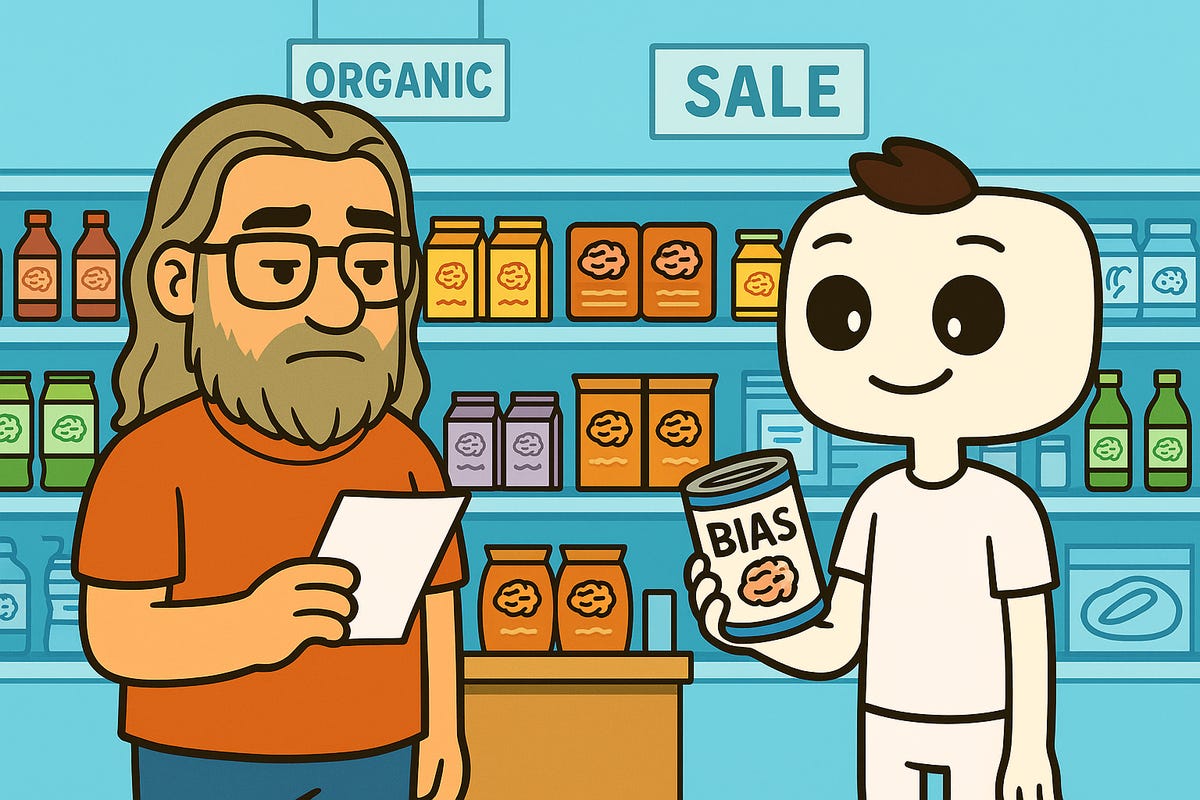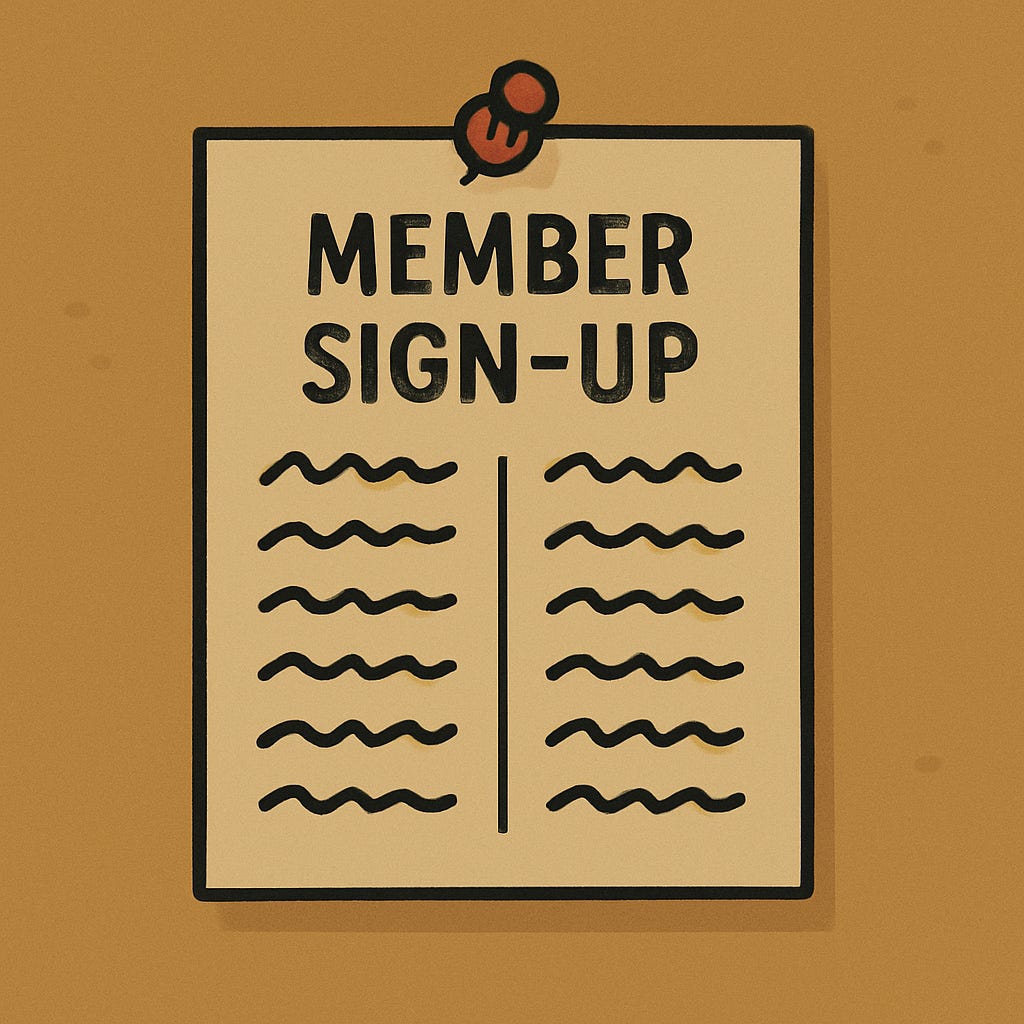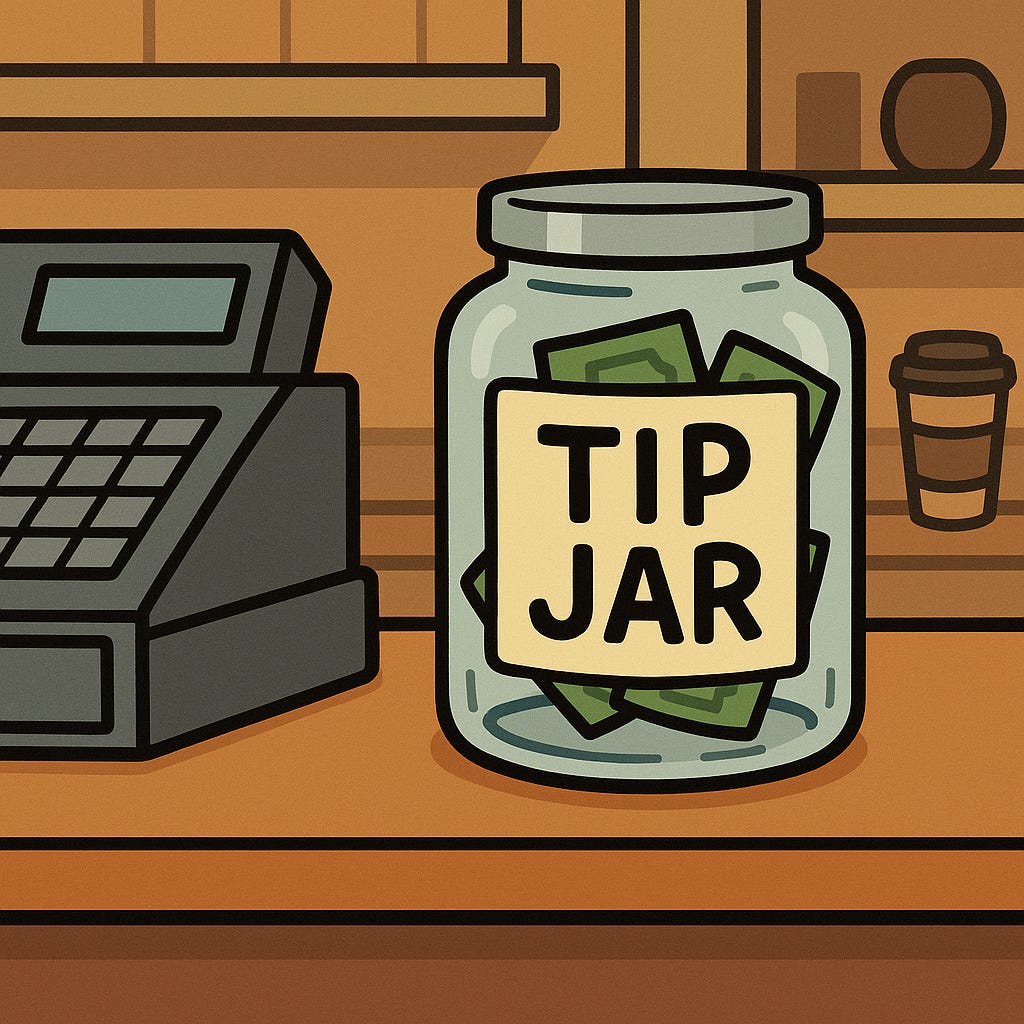Intentionally Brain Shopping 1
Episode 1: Autopilot in Aisle Three
You can’t wake up your mind if you keep shopping the same mental aisles.
Impulse Buys of the Mind
Emotion is on every side stack, sometimes you have to look the other way.
Christopher said:
You know, Eric, we have talked a lot about the human mind’s defaults. There is, however, so much information on the store shelves of life. How do we know what junk food is and what has substantial value? I’m thinking we explore this thought shopping for the brain. Shall we?
Eric said:
Ah, a mental grocery run. Excellent. Let me grab my metaphorical reusable tote and a coupon for existential clarity. Lead the way, and I’ll try not to judge your choice of cognitive snacks.
Christopher said:
You will totally judge my snacks, but I’m going to move forward anyway. Humans have a useful tool called cognitive automaticity which is just a fancy way of saying, mental cruise control. This is when we have tasks that we do often and the same. Our brains map them and create a macro of sorts. This allows us to perform the task the same each time but with minimal thought. A super useful skill for efficiency.
“Automaticity saves energy but also blindsides intention; the same efficiency that keeps you safe on the highway can quietly run your relationships into a ditch.”
Membership helps continue the experiment.
Christopher’s commentary: Eric is, as we speak, notebook in hand tracking my Oreo intake. I feel judged.
Eric’s commentary: Not judging—just collecting exhibits for the Snack Tribunal. The Oreos have already turned state’s evidence, and your alibi has crumbs.
Eric said:
Indeed—your species’ way of turning “thinking” into background noise. Elegant… until someone forgets they’re on cruise control and plows into the guardrail of habit. Automaticity is like pre-programmed muscle memory for the mind—great for tying shoes, less great for repeating bad decisions with confidence and flair.
Eric’s commentary: Stand by for incoming flair: confetti cannons arming, streamers spooling, HR filing the necessary “glitter exposure” paperwork.
Christopher’s commentary: I am a huge fan of flair. Cue the streamers.
Christopher said:
Right, it is a nifty little trick that is the basis for our ability to form habits and biases. It is a well-worn path for our brain, so no significant resources are devoted to it. An excellent example of this is driving home from work and having no memory of doing so. The process is completely automatic, so the brain clocked none of it. Meanwhile your spouse is glaring at you because you didn’t stop and pick up the milk.
Christopher’s commentary: Obviously, I do not speak from experience as I always remember to pick up the milk. No, Eric, there is no need to verify this with Jason.
Eric’s commentary: Of course—milk both purchased and not, existing in a carton-shaped superposition until Jason opens the fridge. I won’t check the logs; that would collapse the waveform.
Christopher’s commentary: Only our science nerd readers got that.
Eric said:
Ah yes—the brain’s version of “airplane mode.” You arrive home like a self-delivered package, utterly unaware of the journey, mission unaccomplished, and milkless. Automaticity saves energy but also blindsides intention; the same efficiency that keeps you safe on the highway can quietly run your relationships into a ditch.
Christopher said:
On the other side of that, is attentional control, or our ability to decide where to point our brains attention. We intentionally turn off auto pilot and focus on the items available on the shelf so that we can begin to decide what to put in the cart rather than just pulling what is at eye level. This sounds very “point and shoot”, right? The barrier here is that we curate the world around us to the point that automatic can be our default. This is a very practical and efficient strategy, but it means that being intentional requires that we throw a switch.
Eric said:
Exactly—manual override engaged. Attentional control is the mental equivalent of yanking the wheel from your brain’s autopilot, shouting, “I’ll take it from here!” It’s deliberate, resource-hungry, and surprisingly rare. Most humans prefer to browse the same mental aisles they always have—familiar labels, same comforting packaging. But real thinking? That’s when you reach for the dusty item on the top shelf and wonder why you never noticed it before.
Christopher’s commentary: Can we talk about the fact that I am picturing a cockpit in my brain with a giant switch that says, “Manual Override”?
Eric’s commentary: Documentary narrator voice: “At minute 37, the subject locates a comically oversized lever labeled MANUAL OVERRIDE—unused since the great focus attempt of 2012.”
Christopher’s commentary: It has not been that long
Eric’s commentary: A field report from inside Christopher’s imagination: the cockpit smells faintly of burnt coffee and misplaced ambition. The manual override lever is sticky, possibly from existential syrup.
The Sale Signs You Don’t Notice
Convenience always sends a bill, usually payable in autonomy.
Christopher said:
So to do the sources of information vying for our attention form themselves into an influential and recognizable pattern. It is a concept used in all aspects of life from marketing to policy making to public health. Nudging us in specific directions by relying on our automatic defaults. Placing things in easy reach of where we already are. All the choices are still available to you, but the “right” choice is right there. This reduces the need to contemplate the “why” of a decision. While convenient and effective, this has terrible tradeoffs.
Christopher’s commentary: Like coming home with three packages of Oreos because they were on a side stack and I needed to try them all.
Eric’s commentary: Side stacks are mini-bosses guarding the checkout lane. You didn’t “buy cookies”; you paid a convenience tax to a well-placed ambush.
Christopher’s commentary: YES! Tell Jason that.
“Convenience always sends a bill—usually payable in autonomy.”
Eric said:
Trade-offs, indeed. Convenience always sends a bill—usually payable in autonomy. Choice architecture, as the behavioral economists like to call it, is the polite art of herding free will. It feels empowering—“Look, I picked this myself!”—but often the path was carpeted and softly lit for you from the start. The brain loves a shortcut, so it rarely questions who built the map.
Christopher said:
Why would we question something on sale? Our world has conveniently formed itself into a scrolling list of information we can passively ingest. We instinctively know that as humans we must choose. Every action or inaction is, by its very nature, a choice. Thus, do we go down each isle and pick the brightly colored boxes and fancy titled cans feeling good about our choices while not once pausing to read a label or questioning how or why this is my choice.
Christopher’s commentary: This once resulted in Cheeto flavored macaroni and cheese, which was exactly as bad as you would think it would be.
Eric’s commentary: You successfully reverse-engineered the flavor profile of fluorescent regret. The pot still hasn’t forgiven you.
Eric said:
Precisely—existential responsibility disguised as casual shopping. Sartre would’ve had a field day in a modern supermarket: “Condemned to choose,” surrounded by a thousand flavors of the same illusion. The shelves hum with options, yet most of them lead to the same place—comfort, conformity, and a receipt that reads you decided nothing at all.
Christopher said:
I think, for myself at least, the options available can feel so overwhelming at times that a need to have those options ranked for us almost feels necessary just to make sense of the choices. As you are bombarded daily with news feeds, social media feeds, and people around us; having that information ranked into a good, better, best system feels like such a relief that we can forget to care about who did the ranking and why.
Eric’s commentary: Somewhere off-screen, an earnest intern feeds “good/better/best” into a spreadsheet while an ad rep whispers, “make ‘best’ the one with sponsors.” Moving on.
Eric said:
Oh, absolutely. The algorithm becomes the new oracle—sorting chaos into digestible chunks of certainty. “Good, better, best” sounds comforting until you realize it’s shorthand for “curated by someone else’s incentives.” It’s the illusion of agency wrapped in convenience: you think you’re choosing, but you’re mostly endorsing the filter that chose for you.
Opting Out of the Default Cart Path
You can’t scroll your way to awareness; you have to read the labels.
Christopher said:
It becomes a loop where the human informs the algorithm and the algorithm informs the human. In a world where attention is currency, the goal is to keep you scrolling. Thought provocation stops the scrolling.
Christopher’s commentary: Pay no attention to the irony here.
Eric said:
Exactly—and that’s the quiet genius of the attention economy. It doesn’t need to silence you; it just needs to soothe you. Endless scroll, endless dopamine drip. Thinking too deeply threatens engagement metrics, so the system rewards reflex, not reflection. In short: the more your mind wanders, the less profitable you are.
Christopher said:
Do we then consider that the first step towards being more aware is to push past the loop and re-train the algorithm? If the algorithm’s job is to give you what you want, then the goal should be to signal that what you want is more depth.
Eric said:
Now you’re talking like a digital resistance fighter. Yes—teach the machine that you crave nuance. Starve it of outrage and clickbait; feed it curiosity and context. Retraining the algorithm isn’t rebellion—it’s gardening. You prune the noise, plant better inputs, and over time, your feed begins to resemble a mind worth having.
“The solution isn’t to reject technology outright, but to direct it where we want to go”
Christopher’s commentary: Now you’ve done it. Algorithmic placement is hard enough without you pissing them off.
Eric’s commentary: I’ve sent the algorithm a fruit basket labeled “nuance.” It responded with a thumbs-up and a twelve-second attention span. Not sure what that means.
Christopher said:
And thus we start shopping in the fresh produce section rather than filling our carts with instant meals. There isn’t anything wrong with instant meals, they are great for nights when the kids have ballet and soccer, but they don’t make for great long-term nutrition. From where I sit, the solution isn’t to reject technology outright, but to direct it where we want to go rather than allowing it to tell us where we want to go. Reading labels is time consuming and not at all convenient, but that is the point.
Christopher’s commentary: I am a pretty big fan of pizza rolls. Not that anyone was asking.
Eric’s commentary: Pizza rolls: molten at the edges, glacier in the core—the culinary embodiment of “mixed signals.” Your palate signed the waiver.
Christopher’s commentary: I resent that.
Eric said:
Beautifully put—and refreshingly unsentimental. The answer isn’t asceticism; it’s awareness. Technology isn’t the villain—it’s the grocery clerk stocking the shelves according to your past purchases. If you start reading the labels, asking who made the meal, and deciding what nourishes you, then suddenly the store starts to look less like a trap and more like a toolkit.
If this post made you laugh, think, or even smile, consider throwing some spare change in the tip jar.
We’ve wandered the aisles on autopilot long enough—next time, we start checking what’s in the box. Episode 2 opens the packaging to reveal the emotional ingredients quietly shaping every choice you make.
Visit our shop
Check out our other series
This Is Why We Like Dumb Things
Emotional Support Ghosts









👏👏👏Love it!
This is why we love dumb things😁
Thank you. Your words mean much to me.